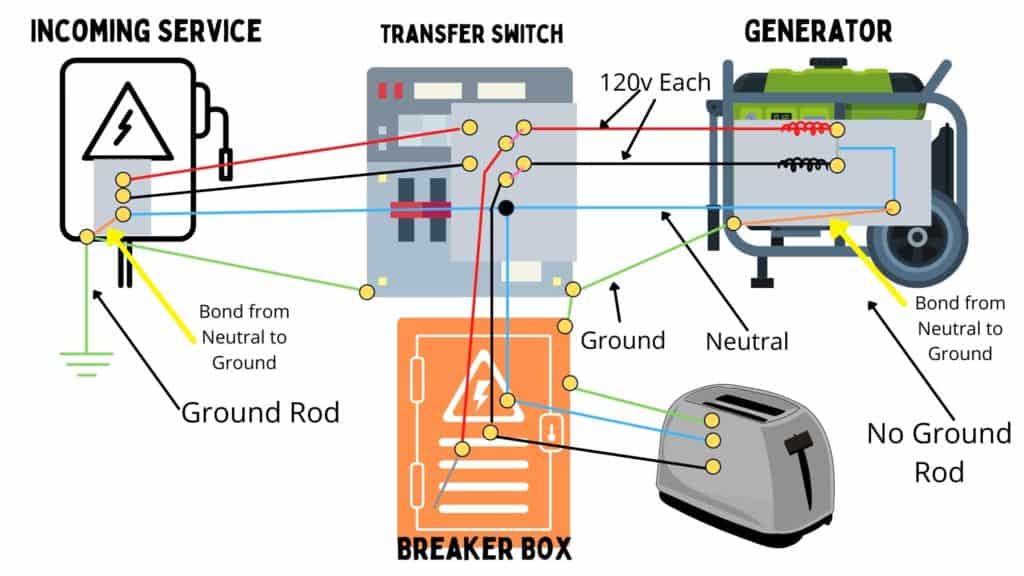You did your due diligence and bought a generator, some gasoline, and even installed a dedicated transfer switch. Everything felt ready to go in the event of a power outage.
Then it happened, and it is your moment to show off to your family and neighbors and be the shining light on the hill in a sea of dark houses… except every single time you turn on the breaker for the generator it immediately trips and your house is no different than everyone else who failed to prepare.
Annoying, right?
Luckily, the solution is likely very simple.
As a general rule, a generator will immediately trip when backfeeding a house because the generator has a bonded neutral. This allows a parallel return path for current back to the generator and the GFCI outlet will open the circuit to prevent shock or electrocution. Removing the bonding jumper will solve this issue.
If that didn’t make sense, just hold on and we’ll get you back in business in no time. I’ve got visuals that you can follow along with.
*** Of course, this article is for entertainment purposes and is not a substitute for consulting with your local certified electrician before tampering with any electrical components.
Why is My Generator Tripping Immediately After Turning on the Circuit Breaker to Power My House?
Many generators that are 5kW (5,000 watts) and above come equipped with a GFCI circuit breaker. GFCI stands for Ground Fault Current Interrupt. Generators this size are also commonly used on construction sites and are OSHA compliant with this GFCI outlet and a bonded neutral and ground.
To keep things simple, a GFCI breaker measures the current leaving through the hot wire and returning on the neutral. It will only operate if the two are equal. If there is even a small variation with the return current, the GFCI recognizes that current is leaking somewhere in the circuit and will trip in order to prevent shock or electrocution.
Our problem is twofold. Firstly, the generator being used has a bonded neutral to the grounding circuit and the house already has a bonded neutral to the grounding circuit. Secondly, the transfer switch being used keeps the neutral intact between the house’s service, the transfer switch, the generator, and the circuits being powered.
These two combinations are at odds with each other and will always trip a GFCI outlet. In certain situations you want each of them, but not together at the same time.
Side note, just in case you were interested in learning when you DO and DO NOT need to ground your generator, feel free to check out my article here.
This creates two paths back to the source of the power (the generator) for the return current. You’ve essentially made a circuit within a circuit and some of the current will travel back along the neutral and a portion will travel back via the ground.
Without a visual, it is probably very difficult to conceptualize what’s happening.
Let’s take a look below at what the situation SHOULD look like first.

As you can see, as we are powering our toaster, the current will leave out through the hot (black one, in this case) and will return through the neutral wire since that is the only path back to the source during normal operations.
However, the situation you’re likely experiencing can be seen below.

When you compare these pictures there’s only one real difference — the generator has a bonding jumper between the neutral and the ground.
Now, under normal conditions, the power will leave the generator through the black hot, pass through the transfer switch and down to the panel where it will power our toaster. However, on the return path, some of the current will ride up the neutral and back to the generator while some of it will travel up the neutral, back to the incoming service, jump across the bonding jumper and down to the ground, and travel the ground back to the generator.
Since the generator is also bonded (there should only be one point in the system where there is a neutral to ground bond!), the current coming back on the ground jumps back up to the neutral and completes the circuit there as well.
GFCI outlets are extremely sensitive and they will sense this issue faster than you can blink and will turn off.
How to Fix a Generator That Immediately Trips When Powering a House
If your transfer switch keeps the neutral intact and doesn’t switch the circuit being used over to the generator only, then we need to get our system looking like the first picture in the section above.
That means that the bonded neutral in the generator needs to become a floating neutral.
The process for this is relatively simple in most generators.
Simply remove the cap for the alternator portion of your generator.
From there, you should see a small jumper leading from the neutral over to the grounding point.

Remove that jumper, screw everything back in place, and replace the cover.
Your generator should now be ready to rock!
Keep in mind though that your generator is now a floating neutral generator and will not offer shock or electrocution protection in the event of a hot-to-case fault when using extension cords to power appliances and power-tools.
Make a note of the fact that your generator is now a floating neutral on a piece of tape and place it prominently on the generator (with the jumper under the tape) so that you and others are aware of this for future use.
If you were to use extension cords for something in the future, you would want to replace that jumper.
Since your house is bonded and the neutral is intact, you will have protection from a hot-to-case fault even with the generator’s bonding jumper removed.

